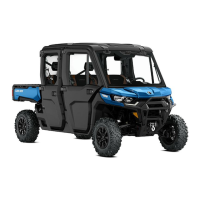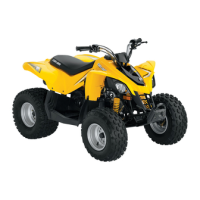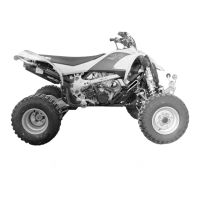RIDING YO UR VE H ICLE
Emergency Engine Stopping
Exercise
Learn how to stop your engine quickly
in a n emergency situa tion.
– While running at low speed, si mply
turn the key to the off position.
This is to familiarize you with the ve-
hicle’s reaction when the engine is
turned off while driving a nd to devel op
this reflex.
Off-Road Operation
The very nature of off-road op eration
is dangerous. A ny terrain, which has
not been specially prepa red to carry
vehicles, presents a n inherent danger
where terrain subs tance, shape and
steepness are unpredi ctabl e. The ter-
rain itself prese nts a c ontinual elem ent
of danger, which must be k nowin gly
accepted by anyone venturing over it.
An o pera tor who takes a v ehicle
off-road s hould alwa y s exercise the ut-
most care in selecting the safest path
and keeping close watch on the ter-
rain ahead of him. T he vehi cle should
never be op erate d by an yo ne who is
not completely familiar with the driving
instructions applicable to the vehicle,
nor should it be operated on steep or
treacherous terrain.
General Rid in g Techniques
General Driving Tips
Care, caution, experience a nd driving
skill are the best precautions against
the hazards of vehicle opera tion.
Whenev er the re is the slightest doubt
that the vehicle can safely n egotiate an
obstacle or a particular piece of terrain,
always choose a n a lternate route.
In off-road operation, power and trac-
tion, not s peed, ar e importa nt. Never
drive faster than visibility and your own
ability to select a safe route permit.
Always go slowly an d be extra care ful
when operating on un familiar terra in.
Always be alert to changing terrai n c on-
ditions w hen operating this ve hicle.
Be espe cially cautious on excessively
rough, slippery, icy or loose terrain.
Constantly watc h the terrain a hea d
for sudde n cha nges in slopes or ob-
stacle s, such as rocks or stumps, that
may cause loss of stability, resulting i n
tipoverorrollover.
Never opera te the vehicle if t he con-
trols do not func tion normally. See an
authorized Can-A m dealer.
To m a intain proper control it is s trongly
advised t ha t you keep y our hands on
the steering wheel and within easy
reach of all con trols. T he same holds
true for your feet. To minimize the pos-
sibility of a ny leg or foot i njury, keep
your left foot on the footrest and right
foot on the floor at all times. Staying
completely within the cockpit will also
help keep you from s triking objects
outside the vehicle.
Watch for and avoid branches and
other foreign objects tha t cou ld en-
ter the passenger com partm ent and
strike y ou or your pa s senge rs.
Operating in Reverse
When operating in reverse, chec k that
the path b ehind the vehicl e is free of
people or obstacles. Pay attention to
blindspots. Whenitissafetoproceed
in reverse, go slowly and avoid sharp
turns.
WARNING
Steering inputs in reverse opera-
tion increase the risk of rollo
ver.
NOTE: In reverse operation, the en-
gine RPM is limited thus limiting the
vehicle reverse s peed.
WARNING
When driving downhill in reverse,
gravity can increase the vehicle
speed above safe reverse speed.
22
_______
SAFETY IN FORM ATION
________

